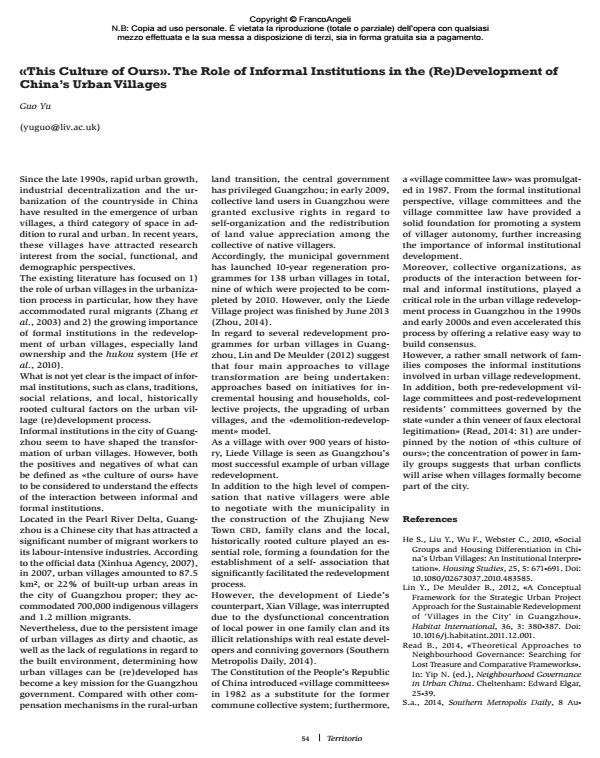«This Culture of Ours». The Role of Informal Institutions in the (Re)Development of China’s Urban Villages
Journal title TERRITORIO
Author/s Guo Yu
Publishing Year 2015 Issue 2015/74 Language English
Pages 2 P. 54-55 File size 235 KB
DOI 10.3280/TR2015-074009
DOI is like a bar code for intellectual property: to have more infomation
click here
Below, you can see the article first page
If you want to buy this article in PDF format, you can do it, following the instructions to buy download credits

FrancoAngeli is member of Publishers International Linking Association, Inc (PILA), a not-for-profit association which run the CrossRef service enabling links to and from online scholarly content.
Osservare oggi le danwei, unità di lavoro socialiste, significa scoprire un interessante laboratorio di progetto urbano per la Pechino contemporanea. La loro presenza nel tessuto urbano testimonia ancora oggi l’organizzazione della città post- 1949, e offre un’esperienza urbana capace di mediare tra gli hutong e i «superblocchi» contemporanei. Una delle loro principali caratteristiche è la configurazione mista: nello stesso recinto fabbriche, case, scuole, palestre, club di lavoratori. Se guardiamo in particolare alle danwei industriali, ciò le rende «urbane» quasi per definizione, in contrapposizione con le fabbriche europee la cui scala, con poche eccezioni, rappresenta una frattura nel tessuto urbano. Il patrimonio industriale cinese si presta pertanto a pratiche di riuso dedicate non tanto al singolo oggetto, ma al tessuto urbano. È possibile immaginare strategie innovative di recupero delle danwei, ispirate alla tradizione europea dell’urbanistica dialogica, e basate su una ricca comprensione della stratificazione di memorie?
Keywords: Beijing; danwei; rigenerazione urbana
- He S., Liu Y., Wu F., Webster C., 2010, «Social Groups and Housing Differentiation in China’s Urban Villages: An Institutional Interpretation ». Housing Studies, 25, 5: 671-691. DOI: 10.1080/02673037.2010.483585
- Lin Y., De Meulder B., 2012, «A Conceptual Framework for the Strategic Urban Project Approach for the Sustainable Redevelopment of ‘Villages in the City’ in Guangzhou». Habitat International, 36, 3: 380-387. DOI: 10.1016/j.habitatint.2011.12.001
- Read B., 2014, «Theoretical Approaches to Neighbourhood Governance: Searching for Lost Treasure and Comparative Frameworks».
- In: Yip N. (ed.), Neighbourhood Governance in Urban China. Cheltenham: Edward Elgar, 25-39.
- S.a., 2014, Southern Metropolis Daily, 8 August, «Guangzhou xiancun gaizao bao fubai tiesanjiao» («The Corruption Triangle in the Redevelopment Process in Xian Village in Guangzhou»).
- Xinhua Agency, 10 January 2007, «Guangzhou 138tiao chengzhongcun sanyue qian jian huanweidui» («At the End of March 2007, there were in Total 138 Urban Villages with Environmental Protection Groups in Guangzhou»).
- Zhang L., Zhao S.X.B., Tian, J.P., 2003, «Selfhelp in Housing and chengzhongcun in China’s Urbanization». International Journal of Urban and Regional Research, 27: 912-937. DOI: 10.1111/j.0309-1317.2003.00491.x
- Zhou Z., 2014, «Towards Collaborative Approach? Investigating the Regeneration of Urban Village in Guangzhou, China». Habitat International, 44: 297-305. DOI: 10.1016/j.habitatint.2014.07.01
Guo Yu, «This Culture of Ours». The Role of Informal Institutions in the (Re)Development of China’s Urban Villages in "TERRITORIO" 74/2015, pp 54-55, DOI: 10.3280/TR2015-074009